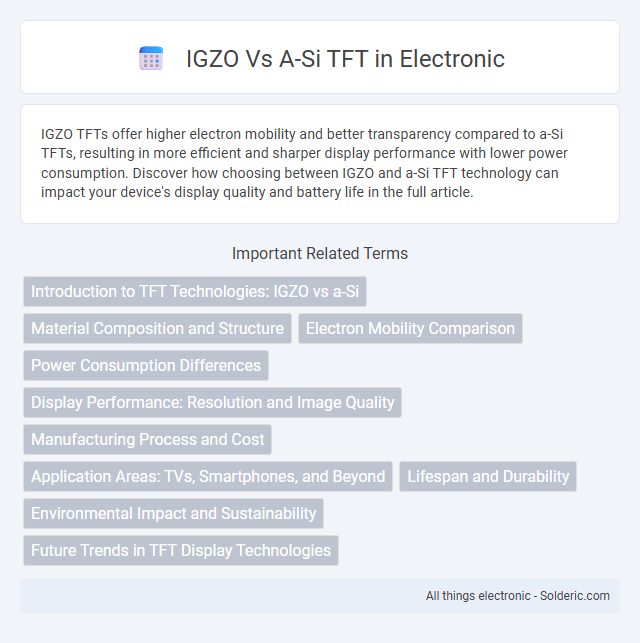IGZO TFTs offer higher electron mobility and better transparency compared to a-Si TFTs, resulting in more efficient and sharper display performance with lower power consumption. Discover how choosing between IGZO and a-Si TFT technology can impact your device's display quality and battery life in the full article.
Comparison Table
| Feature | IGZO TFT | a-Si TFT |
|---|---|---|
| Material | Indium Gallium Zinc Oxide | Amorphous Silicon |
| Electron Mobility | 10-50 cm2/V*s | 0.5-1 cm2/V*s |
| Switching Speed | High | Low |
| Power Consumption | Low | Higher |
| Display Applications | High-resolution LCD, OLED | Standard LCD |
| Manufacturing Cost | Higher | Lower |
| Stability | Better stability under bias stress | Susceptible to degradation |
| Transparency | Transparent semiconductor | Opaque |
Introduction to TFT Technologies: IGZO vs a-Si
IGZO (Indium Gallium Zinc Oxide) and a-Si (amorphous Silicon) are prominent TFT technologies used in display panels, each offering distinct advantages. IGZO provides higher electron mobility, leading to faster switching speeds and improved image quality, making it ideal for high-resolution displays and energy-efficient devices. Your choice between IGZO and a-Si TFTs depends on priorities like performance, power consumption, and cost-effectiveness in display applications.
Material Composition and Structure
IGZO (Indium Gallium Zinc Oxide) TFTs utilize a metal oxide semiconductor composed of indium, gallium, zinc, and oxygen atoms arranged in an amorphous crystalline structure, offering high electron mobility and uniformity. In contrast, a-Si (amorphous silicon) TFTs use a silicon-based semiconductor with a disordered atomic arrangement, resulting in lower electron mobility and increased susceptibility to defects. The metal oxide composition of IGZO enables superior electrical performance and stability compared to the silicon-based a-Si structure in thin-film transistors.
Electron Mobility Comparison
IGZO (Indium Gallium Zinc Oxide) TFTs exhibit significantly higher electron mobility compared to a-Si (amorphous Silicon) TFTs, typically ranging from 10 to 50 cm2/V*s, whereas a-Si TFTs have electron mobility around 0.5 to 1 cm2/V*s. This substantial difference enhances your display's performance with faster switching speeds, improved resolution, and better power efficiency. Choosing IGZO technology is crucial for applications demanding high-speed and high-definition displays.
Power Consumption Differences
IGZO (Indium Gallium Zinc Oxide) TFTs consume significantly less power compared to a-Si (amorphous Silicon) TFTs due to higher electron mobility, enabling faster switching at lower voltages. This results in reduced energy usage for displays, making IGZO ideal for battery-powered devices like smartphones and laptops. Your device's battery life can greatly improve by choosing IGZO technology for its superior power efficiency.
Display Performance: Resolution and Image Quality
IGZO TFT technology offers superior display performance compared to a-Si TFT by enabling higher resolution and improved image quality due to its greater electron mobility and reduced power consumption. This allows your screens to deliver sharper images, enhanced color accuracy, and better brightness uniformity. As a result, IGZO-based displays are well-suited for high-definition devices requiring vivid visuals and efficient energy use.
Manufacturing Process and Cost
IGZO (Indium Gallium Zinc Oxide) TFTs involve a more complex manufacturing process with sputtering techniques that require precise control of material composition, leading to higher production costs compared to a-Si (amorphous Silicon) TFTs. a-Si TFTs benefit from mature, low-temperature deposition processes that are cost-effective and widely used in large-area display manufacturing. Your choice depends on balancing the superior performance and smaller pixel size enabled by IGZO against the lower cost and established manufacturing infrastructure of a-Si TFT technology.
Application Areas: TVs, Smartphones, and Beyond
IGZO TFT technology offers higher electron mobility and better power efficiency compared to a-Si TFT, making it ideal for high-resolution TVs and smartphones with vibrant displays and longer battery life. a-Si TFT remains widely used in cost-sensitive applications such as lower-end TVs and basic display panels due to its lower manufacturing costs. Your choice of display technology impacts performance and energy consumption significantly, especially in advanced applications like wearable devices and large-sized monitors.
Lifespan and Durability
IGZO (Indium Gallium Zinc Oxide) TFTs offer significantly longer lifespan and enhanced durability compared to a-Si (amorphous Silicon) TFTs, with improved resistance to electrical stress and environmental factors. IGZO's higher electron mobility contributes to lower power consumption and reduced degradation over time, making it ideal for displays requiring sustained performance. a-Si TFTs typically experience faster deterioration due to their inferior charge carrier stability and vulnerability to moisture and temperature variations.
Environmental Impact and Sustainability
IGZO (Indium Gallium Zinc Oxide) TFTs consume less power and exhibit higher energy efficiency compared to a-Si (amorphous Silicon) TFTs, leading to reduced carbon emissions over their lifecycle. IGZO fabrication requires fewer raw materials and enables longer device lifespans, minimizing electronic waste relative to a-Si technology. These factors make IGZO TFTs a more sustainable choice for environmentally responsible display manufacturing.
Future Trends in TFT Display Technologies
IGZO (Indium Gallium Zinc Oxide) TFTs offer higher electron mobility and improved energy efficiency compared to traditional a-Si (amorphous Silicon) TFTs, enabling future displays with faster refresh rates and enhanced resolution. Emerging trends in TFT display technologies emphasize IGZO's potential for flexible, transparent, and ultra-high-definition screens, making it a critical component for next-generation devices. Your investment in IGZO-based displays ensures access to cutting-edge performance and longer device lifespans in the evolving market.
IGZO vs a-Si TFT Infographic

 solderic.com
solderic.com